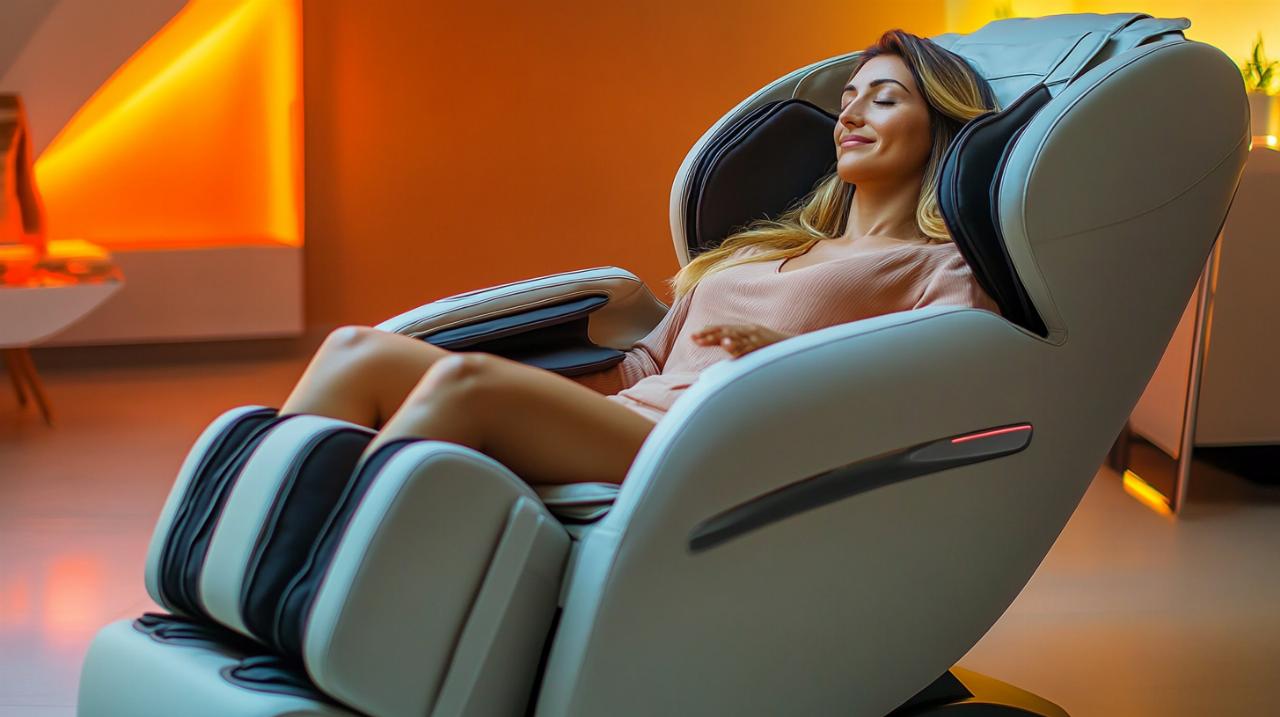When it comes to creating a space for relaxation and wellbeing at home, few investments promise to deliver comfort and therapeutic benefits quite like a massage chair. Whether you're seeking relief from daily aches, looking to enhance circulation, or simply wanting a peaceful retreat after a long day, selecting the right chair for your household requires careful thought. The key to ensuring everyone from your youngest family members to your gran can enjoy the experience lies in finding a model with an intuitive, user-friendly remote control that puts personalised comfort at everyone's fingertips.
Understanding the Importance of an Intuitive Remote Control
Why remote control design matters for family use
The remote control serves as the gateway to all the features and programmes your massage chair has to offer. For a family setting, this means the device must be accessible to individuals of varying ages, technical abilities, and physical needs. An intuitive remote transforms what could be a complex piece of technology into a straightforward tool for relaxation. It allows everyone to tailor their massage experience without frustration or confusion, ensuring that the chair becomes a genuinely inclusive asset in your home. When considering the best massage chair for the family, the remote's design should be a top priority, as it directly impacts how often and how effectively the chair will be used by all household members.
Accessible design elements such as large, clearly labelled buttons and straightforward menus make a significant difference in daily use. Elderly users or those with reduced mobility benefit immensely from controls that don't require intricate dexterity or prolonged study of an instruction manual. Similarly, younger or less tech-savvy family members will appreciate a remote that allows them to quickly access relaxation without navigating layers of menus. The overall goal is to create an experience where pressing a button or two is all it takes to recline, activate a massage programme, and begin unwinding.
Avoiding overly complicated button layouts
A common pitfall with some massage chair remotes is an overabundance of buttons and controls that can overwhelm users. When a remote is cluttered with options, it becomes difficult to identify the essential functions, leading to frustration rather than relaxation. The ideal remote strikes a balance between offering comprehensive control and maintaining simplicity. Quick access buttons for key functions such as reclining, adjusting the leg rest, and starting or stopping massage programmes should be prominently positioned and easy to locate without having to squint at tiny labels or decode cryptic symbols.
Traditional button-based remotes tend to be more durable and easier to operate without looking, which is particularly useful when you're already settled into a comfortable position. Touch screens, while modern and visually appealing, can sometimes lack the tactile feedback that helps users navigate controls confidently. For family use, a remote that prioritises ease of use over technological flair often proves more satisfying in the long run. The focus should always be on minimising the learning curve so that everyone can enjoy the therapeutic benefits without unnecessary hassle.
Essential Features for a Family-Friendly Massage Chair Remote
Pre-set programmes suitable for all ages
One of the most valuable features in a family-friendly massage chair remote is the availability of automatic pre-set modes. These programmes are designed to deliver a complete massage experience lasting typically between fifteen and thirty minutes, targeting common areas of tension such as the back, shoulders, and legs. Pre-set modes simplify the user experience by removing the need to manually adjust intensity, massage type, and zone targeting. Instead, family members can simply select a mode that matches their current needs, whether that's a gentle relaxation session or a more vigorous deep tissue massage.
The variety of pre-set programmes available can cater to different preferences and physical requirements within the household. For instance, a gentle kneading programme might be perfect for an elderly user seeking mild relief, while a younger, more active family member might prefer a programme with higher intensity and varied massage techniques. Brands such as Osaki and Daiwa offer models with an impressive range of auto programmes, some featuring as many as twenty distinct options. This diversity ensures that everyone can find a setting that feels tailored to their personal comfort and therapeutic goals.
Adjustable intensity and massage type options
Beyond pre-set programmes, the ability to manually adjust the intensity and type of massage is crucial for accommodating the diverse needs of a family. A good remote should allow users to seamlessly switch between gentle kneading and a proper deep tissue massage without fumbling through complicated menus. This flexibility is especially important when different family members use the chair throughout the day, each with their own preferences for pressure and massage style.
Advanced massage chairs often incorporate sophisticated roller technology, including three-dimensional and four-dimensional rollers that mimic the hands of a professional massage therapist. The remote should provide straightforward controls to adjust the depth, speed, and focus of these rollers, as well as to activate additional features such as heat therapy and air compression. Heat therapy can enhance relaxation and improve circulation, while air compression soothes muscles and provides a sense of spinal decompression. When these options are easily accessible via the remote, the chair becomes a versatile tool for addressing everything from chronic pain to post-workout recovery.
Personalisation through memory settings
Benefits of individual user profiles
One of the most practical innovations in modern massage chair remotes is the inclusion of user memory functions. This feature allows each family member to save their favourite settings, creating a personalised profile that can be recalled with the touch of a button. The benefits of this functionality extend far beyond mere convenience. It eliminates the need to manually adjust settings every time someone new uses the chair, significantly reducing the time spent fiddling with controls and increasing the time spent actually relaxing.
Individual user profiles are particularly valuable in households where multiple people have distinct preferences or therapeutic needs. For example, one family member might require a low-intensity shoulder massage with gentle heat, while another prefers a vigorous full-body session with air compression targeting the legs. By storing these preferences in memory, the chair becomes instantly adaptable, offering a bespoke experience each time it's used. Brands such as Komoder and Don Descanso have integrated internal memory into their remotes, making it simple to configure and recall personalised settings without any fuss.

How memory functions simplify daily use
The daily use of a massage chair is transformed when memory functions are part of the remote's capabilities. Instead of navigating through various menus and options each time, a user can simply select their saved profile and let the chair do the rest. This simplicity is especially beneficial for elderly users or those with limited technical skills, as it reduces the learning curve and makes the chair feel more intuitive and welcoming.
Moreover, memory functions contribute to a more consistent therapeutic experience. When settings are saved, users can replicate the exact massage conditions that provided relief or relaxation in previous sessions. This consistency is important for managing chronic pain or addressing specific areas of tension over time. The ability to quickly access a familiar and effective massage routine encourages regular use, which in turn maximises the health benefits associated with consistent massage therapy, such as improved circulation, stress relief, and muscle relaxation.
Accessibility and Readability of the Remote Control
Clear labelling and large display screens
For a massage chair remote to be truly user-friendly, clear labelling and a large, easy-to-read display screen are essential. Small, cramped text or ambiguous icons can turn what should be a simple operation into a frustrating guessing game. Large buttons with bold, legible labels ensure that users can quickly identify the function they need without straining their eyes or relying on guesswork.
A well-designed display screen provides visual feedback that confirms the selected settings and guides the user through the available options. This is particularly helpful for those who may not be familiar with the chair's features or who are using it for the first time. Some remotes also incorporate backlighting, which makes the controls visible even in dimly lit environments, adding another layer of convenience and accessibility. The combination of clear labelling and a thoughtfully designed display creates a remote that feels approachable and easy to master, regardless of the user's age or technical proficiency.
Considerations for Users with Visual Impairments
Accessibility extends beyond large text and clear labels to include considerations for users with visual impairments. Tactile differentiation between buttons, such as varied shapes or textures, can help individuals navigate the remote by touch alone. Additionally, remotes that offer audible feedback or voice-guided instructions provide an extra layer of support for those who may struggle with visual interfaces.
While not all massage chairs currently offer these advanced accessibility features, it's worth seeking out models that do if you have family members with specific needs. Some manufacturers are beginning to integrate voice command functionality, allowing users to control the chair through spoken instructions. This innovation represents a significant step forward in making massage chairs accessible to everyone, regardless of physical limitations. When evaluating remotes, consider how well they accommodate the diverse abilities within your household and whether additional accessibility features would enhance the overall experience.
Practical design: size, weight, and ergonomics
Choosing a Comfortable Remote to Hold
The physical design of the remote is just as important as its functionality. A remote that is too large, too heavy, or awkwardly shaped can be uncomfortable to hold and difficult to operate, particularly during longer massage sessions. The ideal remote should fit comfortably in one hand, with an ergonomic shape that allows for easy access to all buttons without having to shift your grip or strain your fingers.
Lightweight materials and a balanced weight distribution contribute to a remote that feels natural and unobtrusive. The remote should be easy to pick up, hold, and operate without causing fatigue or discomfort. Additionally, the placement of buttons should be intuitive, with frequently used controls positioned where they can be reached effortlessly. These design considerations may seem minor, but they have a significant impact on the overall user experience, especially when the goal is to relax and unwind.
Avoiding bulky and unwieldy controllers
A bulky or unwieldy remote can be a right nuisance, detracting from the relaxation experience rather than enhancing it. Large, cumbersome controllers are difficult to store, easy to misplace, and awkward to use when you're already settled into the chair. In contrast, a compact, well-designed remote can be conveniently kept within arm's reach, making it simple to adjust settings as needed without disrupting your comfort.
When evaluating massage chairs, take the time to handle the remote and assess its size, weight, and overall feel. Consider whether it would be easy for all family members to use, including children or elderly individuals who may have less hand strength or dexterity. A remote that is compact yet functional strikes the perfect balance, offering comprehensive control without unnecessary bulk. This attention to practical design ensures that the remote enhances rather than hinders the massage chair experience, making it a seamless part of your family's daily routine.



